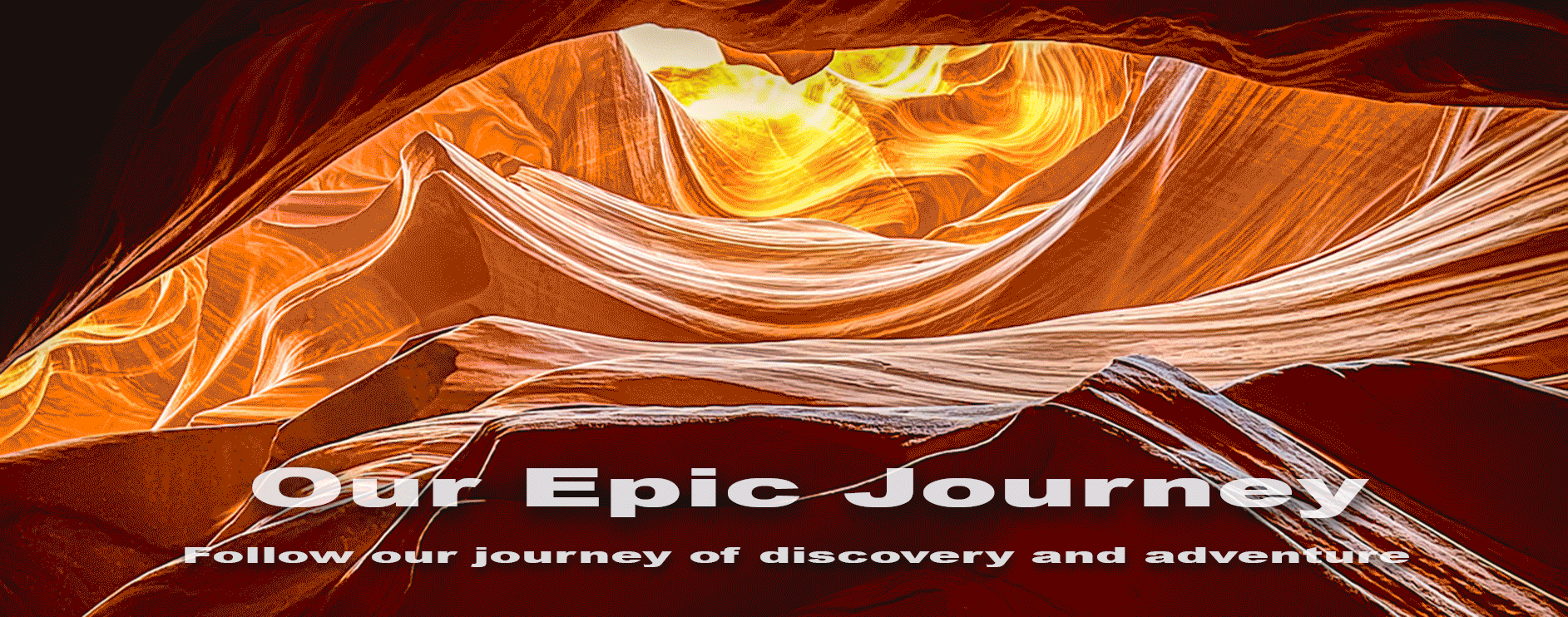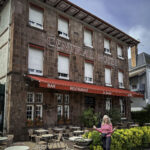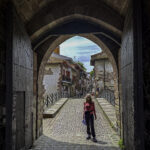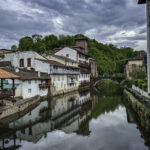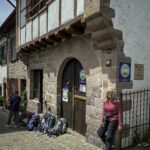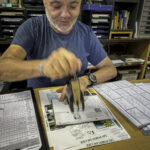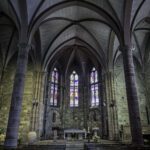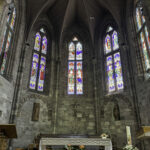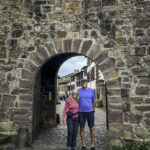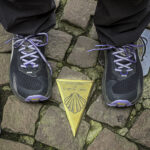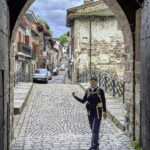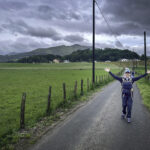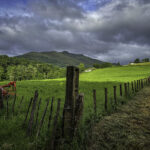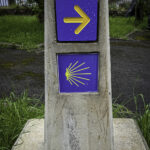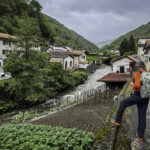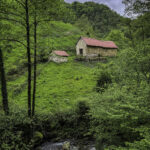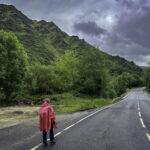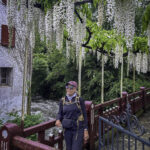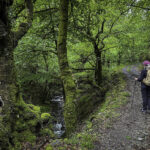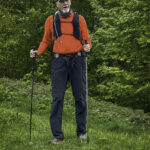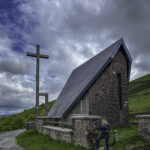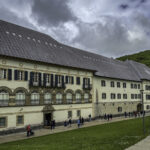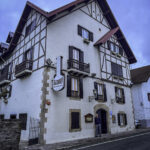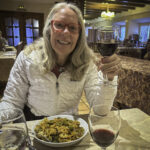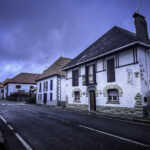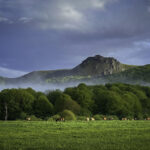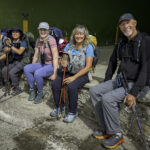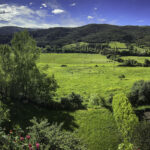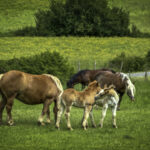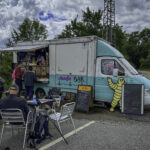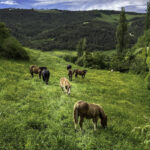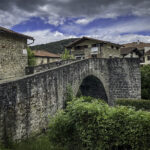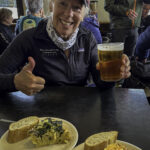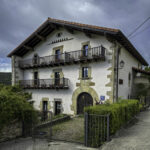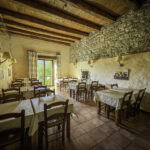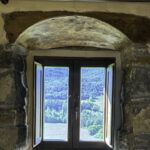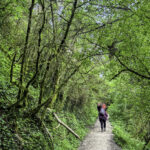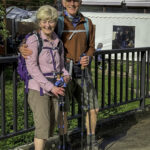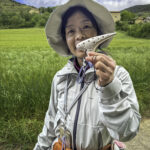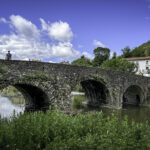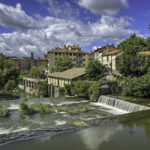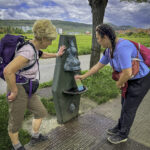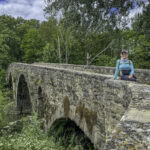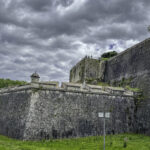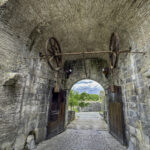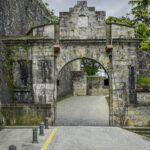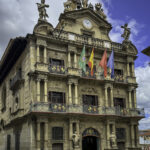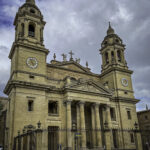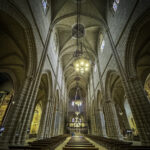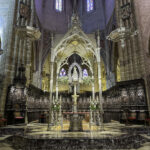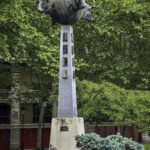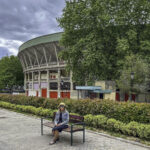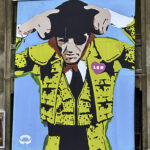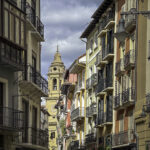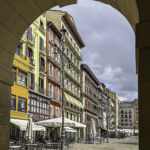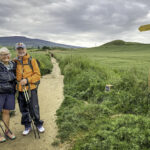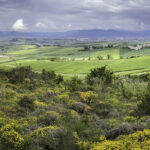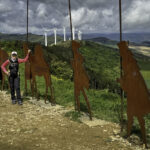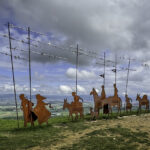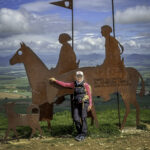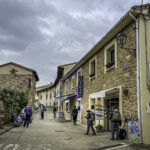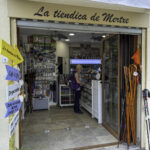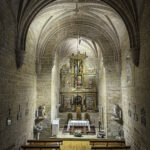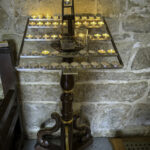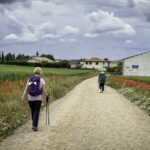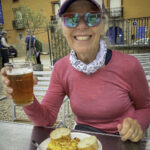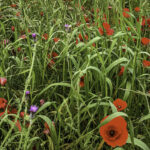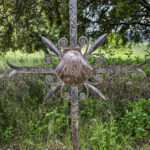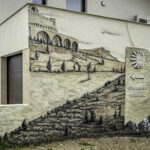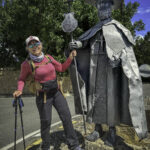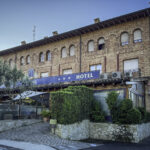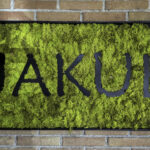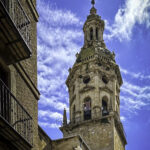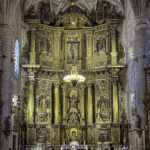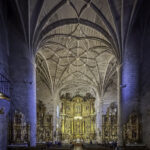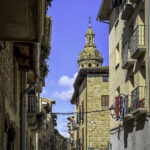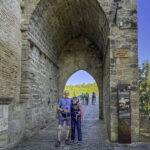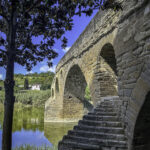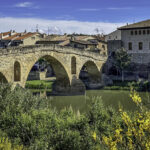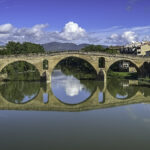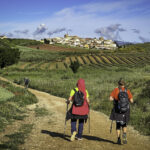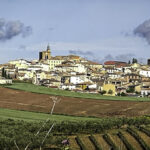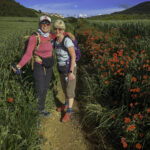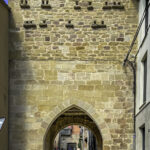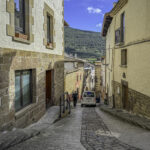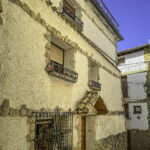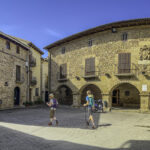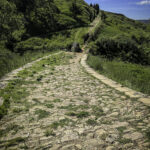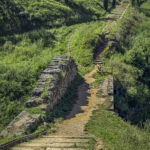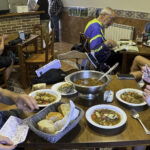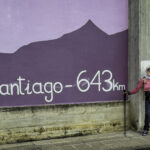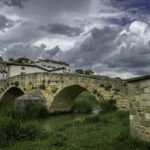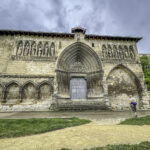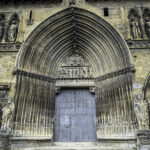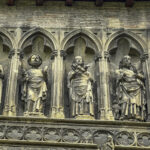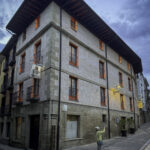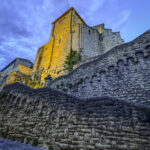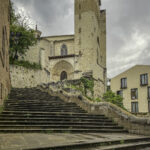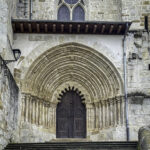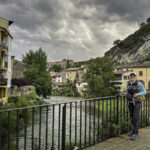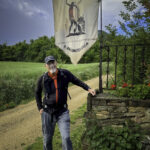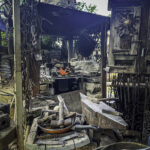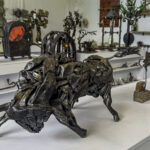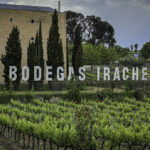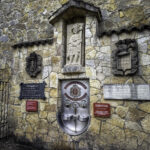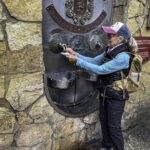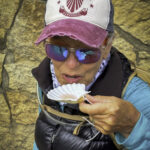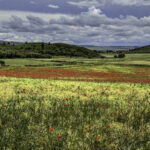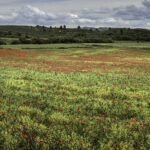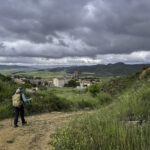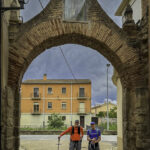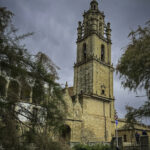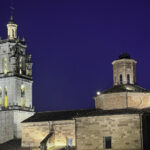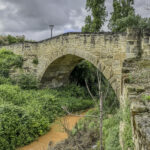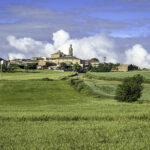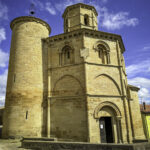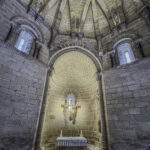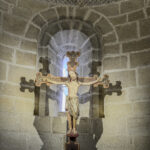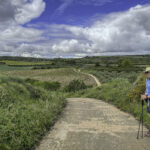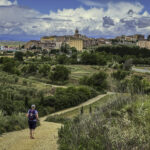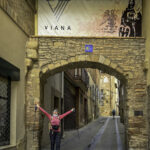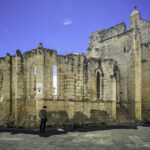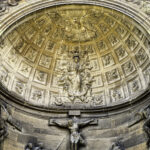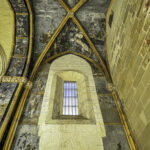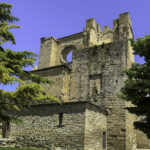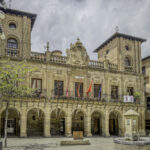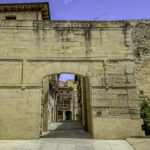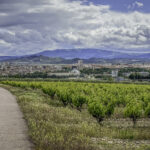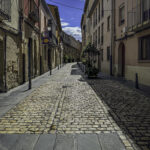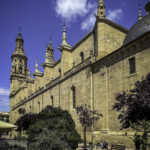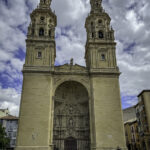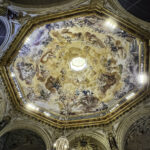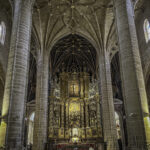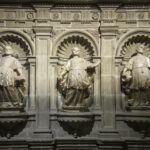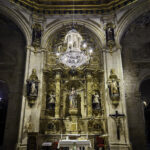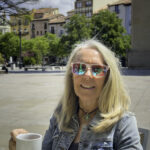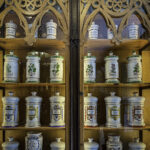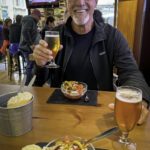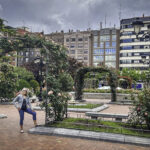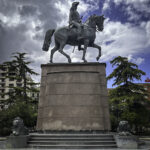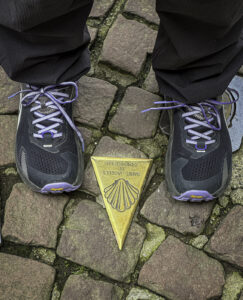 The Camino de Santiago, or the Way of Saint James, is a network of ancient pilgrim routes that converge at the shrine of the apostle Saint James the Great in Santiago de Compostela. The French Way, or Camino Francés, is the most popular route, stretching approximately 780 kilometers from Saint-Jean-Pied-de-Port in France to Santiago in Spain. Historically, pilgrims have walked this path for over a thousand years, seeking spiritual enlightenment and personal growth.
The Camino de Santiago, or the Way of Saint James, is a network of ancient pilgrim routes that converge at the shrine of the apostle Saint James the Great in Santiago de Compostela. The French Way, or Camino Francés, is the most popular route, stretching approximately 780 kilometers from Saint-Jean-Pied-de-Port in France to Santiago in Spain. Historically, pilgrims have walked this path for over a thousand years, seeking spiritual enlightenment and personal growth.
Legend has it that after the martyrdom of Saint James in Jerusalem, his remains were transported to the Iberian Peninsula, where they were eventually discovered in the 9th century by a hermit named Pelayo. Guided by a star, or “campo de estrella” in Spanish, Pelayo found the relics, and the site became known as Compostela. This discovery sparked a wave of pilgrimages, making the Camino de Santiago one of the most important Christian pilgrimages of the Middle Ages, rivaling even Jerusalem and Rome.
Navarre, an autonomous community in northern Spain, boasts a diverse landscape ranging from the lush Pyrenees mountains to the arid plains of the Ebro River. Historically, Navarre was a powerful medieval kingdom, and its strategic location made it a crossroads of cultures and conflicts. Today, it’s a region that celebrates its cultural heritage, evident in its festivals, cuisine, and architecture.
Day 1 St Jean Pied de Port to Roncesvalles, 24 km
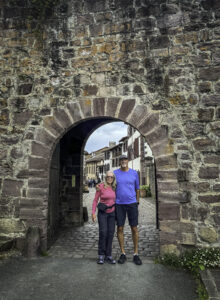 Today, May 14th, we begin our Camino Frances Pilgrimage, on a cloudy morning from St Jean Pied de Port leaving the Hotel Central at 8 am to start the climb on the lower route. This path, known as the “Napoleon Route” alternative, starts in the Basque region of France and crosses into Spain over the Pyrenees. The hike begins with a steady climb out of Saint-Jean, through pastoral scenery with rolling hills, meadows, and scattered farmhouses. We met a nice young couple from Spain and then stopped for lunch in Azanka, offering a well-deserved break during the hike, as it was beginning to rain. With the rustic, peaceful surroundings and a chance to recharge, we enjoyed a small tortilla, my first of many, before continuing the journey toward Roncevalles, “valley of thorns”, (Orreaga in Basque).
Today, May 14th, we begin our Camino Frances Pilgrimage, on a cloudy morning from St Jean Pied de Port leaving the Hotel Central at 8 am to start the climb on the lower route. This path, known as the “Napoleon Route” alternative, starts in the Basque region of France and crosses into Spain over the Pyrenees. The hike begins with a steady climb out of Saint-Jean, through pastoral scenery with rolling hills, meadows, and scattered farmhouses. We met a nice young couple from Spain and then stopped for lunch in Azanka, offering a well-deserved break during the hike, as it was beginning to rain. With the rustic, peaceful surroundings and a chance to recharge, we enjoyed a small tortilla, my first of many, before continuing the journey toward Roncevalles, “valley of thorns”, (Orreaga in Basque).
We still gained significant elevation as we ascended into the woods, but it’s more gradual compared to the more rigorous high route. Along the way, we passed small chapels and shrines, and views of the Pyrenean peaks rising above the valleys through the mist. Upon reaching Roncevalles, we were greeted by the historic monastery, a significant landmark for pilgrims, where we stopped to get our passports stamped. Since the Middle Ages, this collegiate church of Santa Maria de Orreaga/Roncevalles has been a resting place for Pilgrims along the French Way path. We were transported (3 km) to our accommodation tonight at Hotel Rural Loizu in Burguete. This hotel blends modern amenities with the charm of traditional Basque architecture, offering a cozy, restful environment after a long day, 8.5 hours, walking the Camino. This charming seasonal hotel in a half-timbered building dating from the 1900s, has been an inn for pilgrims since the 19th Century, and is located on the St James Way. We enjoyed our first Pilgrim meal of pasta, salad, dessert and wine for 24 euros. What a wonderful start to our journey on the Camino Frances. Click on thumbnail to view images
Day 2 Roncesvalles to Akerreta, 27.5 km
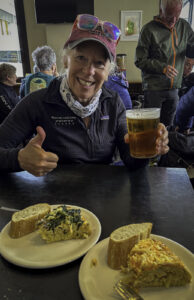 Today we started meeting pilgrims from many different countries. It was a chilly start to our day but a very pleasant walk on the Camino, stopping to take photos of all the new pilgrims we met along the Way. Walked mostly downhill across the fertile plain of the rio Erro, then ascended to the Alto de Erro that forms the ridge that separates the Erro from the Arga river valley. The scenery was very pastoral with lots of cows, horses and pigs grazing in the fields. We stopped for lunch at a beautiful view point and ate our sandwiches gazing across at the green plains in the distance. We continued walking to Zubiri crossing over the Zubiri Puente de la Rabia, a medieval bridge over the rio Arga, into the village. “Named Rabia from the legend that any animal led 3 times around the central arch would be cured of rabies.” We went into a quaint cafe full of pilgrims and ordered a delicious tortilla and a beer, my first beer on the Camino.
Today we started meeting pilgrims from many different countries. It was a chilly start to our day but a very pleasant walk on the Camino, stopping to take photos of all the new pilgrims we met along the Way. Walked mostly downhill across the fertile plain of the rio Erro, then ascended to the Alto de Erro that forms the ridge that separates the Erro from the Arga river valley. The scenery was very pastoral with lots of cows, horses and pigs grazing in the fields. We stopped for lunch at a beautiful view point and ate our sandwiches gazing across at the green plains in the distance. We continued walking to Zubiri crossing over the Zubiri Puente de la Rabia, a medieval bridge over the rio Arga, into the village. “Named Rabia from the legend that any animal led 3 times around the central arch would be cured of rabies.” We went into a quaint cafe full of pilgrims and ordered a delicious tortilla and a beer, my first beer on the Camino.
We left Zubiri to walk the 6 km to our destination for the night, however, Bob was feeling really tired and it took us a very long time. Fortunately, we met Maggie and Gordon White from Scotland along the Way and became instant friends when Maggie said to Bob, “You look like you are dying”! We stayed together at the Hotel Akerreta. This 300 year old beautiful caserio (typical Basque residence), built in 1723, the stone-wall house still conserves its original Pyrenees-style kitchen and its bread oven. The enormous oak wood beams, webbed to create the structure of the house, reveal the historical power of the homestead. A perfect location to enjoy the best of Navarre’s scenery from our room and right on the Camino de Santiago. The Hotel Akerreta is the hotel in the movie “The Way” where the famous actor Martin Sheen meets the American lady in her travel. After a long hot bath and a rest we went for dinner at 8 pm with Maggie and Gordon, whom we became good friends with for life. We enjoyed another Pilgrim meal of cod stew, salad, dessert and of course wine for $27 euros. Click on thumbnail to view images
Day 3 Akerreta to Pamplona, 15 km
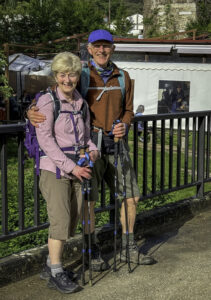
We enjoyed breakfast with Maggie and Gordon before leaving on our walk today to Pamplona. I left with them while Bob stayed back to catch a taxi to Pamplona. The first half of the walk is a tranquil path parallel to the rio Arga. There is plenty of shade along the tree-lined riverbanks and a number of drinking fonts along the Way. I enjoyed walking with Maggie and Gordon, the time pssed by quickly as we talked together most of the way. Soon we met 3 Chinese ladies from Wuhan who were on the path and we stopped to talk with them, only one could speak English. One of the ladies played a small recorder made from bone. She had burned her hand and had a terrible blister. Maggie, who is a very caring nurse, reached into her pack for her first aid kit, and cleaned the wound, put a bandage on it and told her to keep it covered. The lady was so thankful that she played Edelweiss for us, bringing us to tears as we listened to the beautiful sound coming from her instrument. It was so surreal; the music and the setting, the Camino provides when you least expect it.
We continued on our way and came to the beautiful Puente de la Trinidad de Arre, 12th century, historic stone bridge located in Villava. This medieval bridge spans the Arga River and is a key entry point for pilgrims as they approach the city of Pamplona. We came to another historic, medieval bridge, Puente de Magdalena, that crosses the Arga river in a beautiful setting, the Parque de la Tejera, and is the last bridge we cross before reaching the city’s ancient fortifications. It’s Romanesque in style and dates from the 11th and 12th centuries, with five large, slightly pointed arches. After crossing Magdalena Bridge we reached the towering city walls and the Portal de Francia (Gate of France), with its fortress-like appearance, with thick walls and a towering archway that gives a grand sense of arrival. Above the portal, there are battlements and a shield featuring the coat of arms of Pamplona. Just in front of the Portal de Francia, is an old drawbridge, which spans a moat-like section that was once part of the city’s defense system. The drawbridge, now fixed in place, was once raised to protect the city from invaders.
Entering Pamplona through the Portal de Francia and its drawbridge is a memorable and meaningful moment, symbolizing a major milestone on our journey. We walked through the old city until we finally went our separate ways, I went to find Bob at our hotel. Bob and I explored Pamplona, first visiting the Pamplona Cathedral (Santa Maria de la Asuncion), Cathedral of Saint Mary of the Assumption. It is a Roman Catholic church built in the 14th and 15th century, and has a 13th-14th century Gothic cloister that provides access to two other Gothic rooms. Inside, the Cathedral is awe-inspiring. The central nave is grand, with elegant stone columns leading to a high altar adorned with sculptures and religious artwork. One of the key features is the cloister, considered one of the finest examples of Gothic architecture in Europe. The Medieval Kings of Navarre were crowned and some also buried there, King Carlos III of Navarre and his wife lies in the Chapter House. We walked the streets of old town and found Pamplona’s historic bullfighting arena, where the Running of the Bulls takes place in the Plaza de Toros. Click on thumbnail to view images
Day 4 Pamplona to Puente La Reina, 23.3 km
 Today I started walking at 7:30 am, alone, but soon met a couple from Vancouver, WA, Michelle and Dennis; we walked the first 5 km mostly via city pavements and suburban roads together. Then the pathway became a gradual incline until the ascent to Alto del Perdon, which can be challenging, but reaching the summit is rewarding. The iron sculptures on Alto del Perdon (Mount of Forgiveness) are one of the most iconic and symbolic landmarks along the Camino de Santiago Frances, and the vistas looking back towards Pamplona and the surrounding countryside are well-worth the climb. Created by artist Vincente Galbete in 1996, the sculptures depict a group of pilgrims from different eras walking along the Camino. The figures, made from rusted iron, include both men and women, some on foot and others on horseback, representing the long history of pilgrimage along this ancient route. Each figure carries a distinctive style of clothing or gear, reflecting the various periods in history during which people have made this journey. A well-known inscription at the site, written on one of the horses, reads: “Donde se cruza el camino del viento con el de las estrellas”, which translates to “Where the path of the wind crosses that of the stars,” referring to the open, windy ridge where the sculptures stand and the Camino’s connection to the Milky Way, which historically helped guide pilgrims. The site also marks a symbolic point, as it is said that here, pilgrims are “forgiven” for their sins before continuing their journey. After a nice long break here with Maggie and Gordon, we continued down the hill together.
Today I started walking at 7:30 am, alone, but soon met a couple from Vancouver, WA, Michelle and Dennis; we walked the first 5 km mostly via city pavements and suburban roads together. Then the pathway became a gradual incline until the ascent to Alto del Perdon, which can be challenging, but reaching the summit is rewarding. The iron sculptures on Alto del Perdon (Mount of Forgiveness) are one of the most iconic and symbolic landmarks along the Camino de Santiago Frances, and the vistas looking back towards Pamplona and the surrounding countryside are well-worth the climb. Created by artist Vincente Galbete in 1996, the sculptures depict a group of pilgrims from different eras walking along the Camino. The figures, made from rusted iron, include both men and women, some on foot and others on horseback, representing the long history of pilgrimage along this ancient route. Each figure carries a distinctive style of clothing or gear, reflecting the various periods in history during which people have made this journey. A well-known inscription at the site, written on one of the horses, reads: “Donde se cruza el camino del viento con el de las estrellas”, which translates to “Where the path of the wind crosses that of the stars,” referring to the open, windy ridge where the sculptures stand and the Camino’s connection to the Milky Way, which historically helped guide pilgrims. The site also marks a symbolic point, as it is said that here, pilgrims are “forgiven” for their sins before continuing their journey. After a nice long break here with Maggie and Gordon, we continued down the hill together.
The descent was treacherous, very steep on loose boulders, but we managed to make it to the next village of Uterga, for lunch; where I had the best lunch ever, beer and a tortilla with bread. We finally made it to our destination for the night, Puenta la Reina, staying at the Hotel Jakue located in a rustic building with nice views, where I met Bob in our room. We enjoyed a fabulous dinner with Maggie, Gordon, Lynette and Alan from Cape Town, SA, in the hotel dining room. Puenta la Reina named “Queens Bridge” in honour of Dona Mayor, wife of Sancho III. She commanded the magnificent Romanesque bridge to be built to support the safe movement of the increasing number of medieval pilgrims who joined the route at this stage. Click on thumbnail to view images
Day 5 Puenta La Reina to Estella, 21.9 km
 Leaving the Jakue Hotel with Maggie and Gordon we pass under the connecting arch of Iglesia del Crucifijo and Padres Reparadores, and past the beautiful 12th century Iglesia de Santiago. Then we crossed the famous XIIthC “Queen’s Bridge”, Puente la Reina, one of the most beautiful and historically significant bridges on the Camino, connecting pilgrims traveling from both the French and Aragonese routes. The bridge spans the Arga River with six graceful arches, each varying slightly in size, giving it a distinctive, uneven yet elegant profile. Its construction is Romanesque, with large, well-cut stone blocks forming the arches and piers, which have withstood centuries of use by pilgrims, merchants and locals. The view from the bridge is picturesque, with the reflections in the calm river below and the charming medieval town on either side.
Leaving the Jakue Hotel with Maggie and Gordon we pass under the connecting arch of Iglesia del Crucifijo and Padres Reparadores, and past the beautiful 12th century Iglesia de Santiago. Then we crossed the famous XIIthC “Queen’s Bridge”, Puente la Reina, one of the most beautiful and historically significant bridges on the Camino, connecting pilgrims traveling from both the French and Aragonese routes. The bridge spans the Arga River with six graceful arches, each varying slightly in size, giving it a distinctive, uneven yet elegant profile. Its construction is Romanesque, with large, well-cut stone blocks forming the arches and piers, which have withstood centuries of use by pilgrims, merchants and locals. The view from the bridge is picturesque, with the reflections in the calm river below and the charming medieval town on either side.
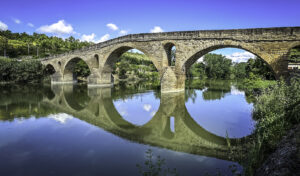 Todays route is along gently rolling farmland and vineyards with few trees and little shade, passing fields of barley and the red sea of poppies lining the path. We arrived at Cirauqui, a medieval hilltop village beautifully preserved with narrow winding streets and houses bearing armorial crests and ornate balconies. We stopped here for a tea/coffee break while enjoying this historical setting. Leaving the village we passed through an arch off the main square and out to one of the best examples of a Roman road on the Camino continuing over a single span Roman bridge. The road, though weathered, still shows the original stonework and features such as embedded grooves from Roman carts, offering a glimpse into the ancient world. This section of the Camino Frances is one of the few places where pilgrims walk on an authentic Roman road, giving it a special historical significance. Walking through this village and Roman road, you can’t help but feel the layers of history, from Roman times to the medieval period, blending into the present. The experience of traversing Cirauqui’s Roman road, surrounded by narrow streets and old stone buildings, is a highlight for pilgrims, connecting them directly to the past.
Todays route is along gently rolling farmland and vineyards with few trees and little shade, passing fields of barley and the red sea of poppies lining the path. We arrived at Cirauqui, a medieval hilltop village beautifully preserved with narrow winding streets and houses bearing armorial crests and ornate balconies. We stopped here for a tea/coffee break while enjoying this historical setting. Leaving the village we passed through an arch off the main square and out to one of the best examples of a Roman road on the Camino continuing over a single span Roman bridge. The road, though weathered, still shows the original stonework and features such as embedded grooves from Roman carts, offering a glimpse into the ancient world. This section of the Camino Frances is one of the few places where pilgrims walk on an authentic Roman road, giving it a special historical significance. Walking through this village and Roman road, you can’t help but feel the layers of history, from Roman times to the medieval period, blending into the present. The experience of traversing Cirauqui’s Roman road, surrounded by narrow streets and old stone buildings, is a highlight for pilgrims, connecting them directly to the past.
We stopped for lunch in the quaint village of Lorca and enjoyed a fabulous bowl of lentil soup. Arriving in Estella, our destination, we passed by the Church of the Holy Sepulchre, one of the oldest parish churches in the village. Iglesia del Santo Sepulcro is a striking example of Gothic architecture, the church dates back to the 12th and 13th centuries. The most remarkable part of the church is its elaborately sculpted Gothic facade, that features a series of beautifully detailed carvings, depicting biblical scenes such as the Last Judgement and various saints. The figures are life-like and dynamic, showcasing the craftsmanship of the time. We could not go inside the church as it is no longer in use for regular worship. We continued to our destination for the night, the town of Estella, known as Estella-Lizarra in Basque, a historic and vibrant town, founded in 1090 by King Sancho Ramirez of Navarre to serve the growing number of pilgrims traveling to Santiago de Compostela. The town’s layout is picturesque, with cobblestone streets, medieval bridges, and well-preserved buildings that give it a charming, old-world feel. We made our way to the Hotel Maisoneuve in the heart of the historic town. After settling in to our room we went out for dinner with Maggie and Gordon to a quaint restaurant on the river. Click on thumbnail to view images
Day 6 Estella to Los Arcos, 21.5 km
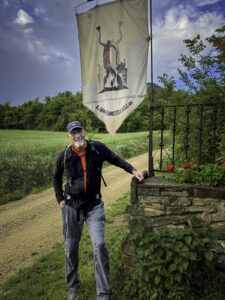 Leaving the Hotel we stopped to look at the Iglesia de San Miguel across the street, built between the 12th and 13th centuries, the church is perched on a hillside overlooking the town and the Ega River. We made our way through the cobblestone streets and across the Ega River on the medieval bridges until we came to an old Blacksmith Shop. This traditional herreria (blacksmith shop) is known for its role in creating custom metalwork, particularly the beautiful bronze bull on display. Next is a must stop on the Camino, the Bordegas Irache and the Wine Fountain. I enjoyed a few sips of the red wine from the Wine Fountain even though it was 8 am in the morning.
Leaving the Hotel we stopped to look at the Iglesia de San Miguel across the street, built between the 12th and 13th centuries, the church is perched on a hillside overlooking the town and the Ega River. We made our way through the cobblestone streets and across the Ega River on the medieval bridges until we came to an old Blacksmith Shop. This traditional herreria (blacksmith shop) is known for its role in creating custom metalwork, particularly the beautiful bronze bull on display. Next is a must stop on the Camino, the Bordegas Irache and the Wine Fountain. I enjoyed a few sips of the red wine from the Wine Fountain even though it was 8 am in the morning.
The rest of the walk was along a delightful natural path surrounded by poppy fields. Arriving in Los Arcos early we had plenty of time to shower and freshen up before heading out to explore the town and church. The Church of Santa Maria de Los Arcos, dating from the 12th century, is a striking example of Gothic, Renaissance, and Baroque architectural styles. Its exterior is impressive, with a tall bell tower, and the church’s massive doorway is intricately decorated with detailed stone carvings. The church was closed tonight because there was a Running of the Bulls in the town square where the church is located. While we waited for the start of the Running of the Bulls, the rain began and made all the streets very wet and slippery. Thus, the running of the bulls was delayed an hour, but when they started running through the square it was still too wet and the bulls fell over too many times. It was a very depressing exhibition to watch as the poor bulls were running everywhere to get away but slipping and falling down. We finally left and went back to Maggie and Gordon’s room for pizza. Their room has a beautiful view of the church’s bell tower lit up at night. Click on thumbnail to view images
Day 7 Los Arcos to Logrono, 27.8 km
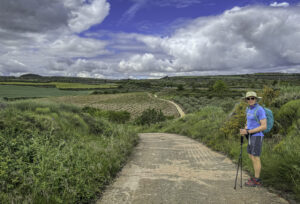 At 8 am the four of us set off on our walk along natural paths through open farmland. Todays walk is very long and there are some short but very steep sections into the Torres del Rio, and when we arrived at Sansol for a break Bob decided to take a taxi to Logrono. We were sitting enjoying our drinks when a taxi passed by the cafe, luckily the driver was stopping for a coffee as well. Bob went in the taxi and Maggie and Gordon and I continued down the path. After walking just 1 km we arrived in Torres del Rio and stopped for lunch at 10:30 am. We also visited the Iglesia de Santo Sepulcro XIIth C linked to the Knights Templar, and stands out for its unique octagonal shape, reminiscent of the Church of the Holy Sepulchre in Jerusalem, which influenced its name. The interior is simple yet striking, featuring an elaborate stone cupola with intricate arches and ribs that create a sense of height and lightness, and a XIIIthC crucifix on the altar.
At 8 am the four of us set off on our walk along natural paths through open farmland. Todays walk is very long and there are some short but very steep sections into the Torres del Rio, and when we arrived at Sansol for a break Bob decided to take a taxi to Logrono. We were sitting enjoying our drinks when a taxi passed by the cafe, luckily the driver was stopping for a coffee as well. Bob went in the taxi and Maggie and Gordon and I continued down the path. After walking just 1 km we arrived in Torres del Rio and stopped for lunch at 10:30 am. We also visited the Iglesia de Santo Sepulcro XIIth C linked to the Knights Templar, and stands out for its unique octagonal shape, reminiscent of the Church of the Holy Sepulchre in Jerusalem, which influenced its name. The interior is simple yet striking, featuring an elaborate stone cupola with intricate arches and ribs that create a sense of height and lightness, and a XIIIthC crucifix on the altar.
Continuing along the path we came to several prayer flags and momorials to loved ones who have passed, remembering them on their journey on the Camino. Soon we arrived at Viana, the Camino passes through its historical center, which is little changed, its architectural heritage still largely intact. We reflected on the ruins of the Church of St. Peter, San Pedro, despite being in ruins the church remains a hauntingly beautiful site. The remnants of its original grandeur visible in the surviving arches, columns, and walls, and the beautiful gardens that lead from it. Built in the early 13th century in a Gothic style, the church was one of the most important religious buildings in the area. We stopped for some afternoon tea in the Square before leaving the town through the medieval stone arch, Portal San Felice; we still had 9 km to go before reaching Logrono and a storm was brewing in the distance. Finally we arrived at our destination at 5:30 pm, and found Bob waiting for me in our room. We went out for dinner with Maggie and Gordon to Calle Del Laurel, a quaint street famous for it tapas bars and pintxos (small bites). It is our last dinner together, they are heading out tomorrow and we are taking a day of rest in Logrono. Click on thumbnail to view images
Day 8 Logrono Rest Day
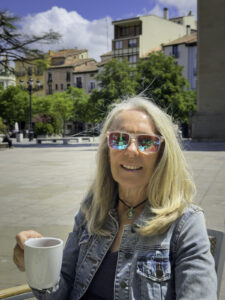 Logrono, the capital of the La Rioja region in northern Spain, famous for its wine, particularly the renowned Rioja wines, Logrono offers a rich blend of history, culture, and gastronomy. This was a perfect place to take our first rest day on the Camino. Slept in until 8:30, breakfast at 9 and got my hair done at a salon near by. Then we walked to the heart of old town, the Plaza del Mercado, to see the Gothic church, Catedral de Santa Maria de la Redonda XIIthC, its impressive twin towers Las Gemelas (the twins) were a later addition. As we stepped inside, we are greeted by a large, spacious nave lined with elegant columns that rise toward a high vaulted ceiling, typical of Baroque architecture’s emphasis on height and grandeur.
Logrono, the capital of the La Rioja region in northern Spain, famous for its wine, particularly the renowned Rioja wines, Logrono offers a rich blend of history, culture, and gastronomy. This was a perfect place to take our first rest day on the Camino. Slept in until 8:30, breakfast at 9 and got my hair done at a salon near by. Then we walked to the heart of old town, the Plaza del Mercado, to see the Gothic church, Catedral de Santa Maria de la Redonda XIIthC, its impressive twin towers Las Gemelas (the twins) were a later addition. As we stepped inside, we are greeted by a large, spacious nave lined with elegant columns that rise toward a high vaulted ceiling, typical of Baroque architecture’s emphasis on height and grandeur.
One of the most striking features is the ornate High Altar, intricately decorated with gilded carvings and statues. The altar is crowned by an impressive retablo (altarpiece) filled with religious iconography, sculptures and saints. The golden tones and detailed craftsmanship of the retablo create a sense of awe and reverence. The interior also features stunning stained glass windows, which bathe the space in colorful light, adding to the atmosphere of sacredness. We gazed with wonder at the harmonious blend of light, color, and ornate decoration, creating a space that is both majestic and deeply spiritual. We continued exploring Logrono and went into a 120 year old pharmacy, and had lunch at a small cafe on Calle del Laurel. Returning to the hotel we had some time to rest before dinner. Click on thumbnail to view images
